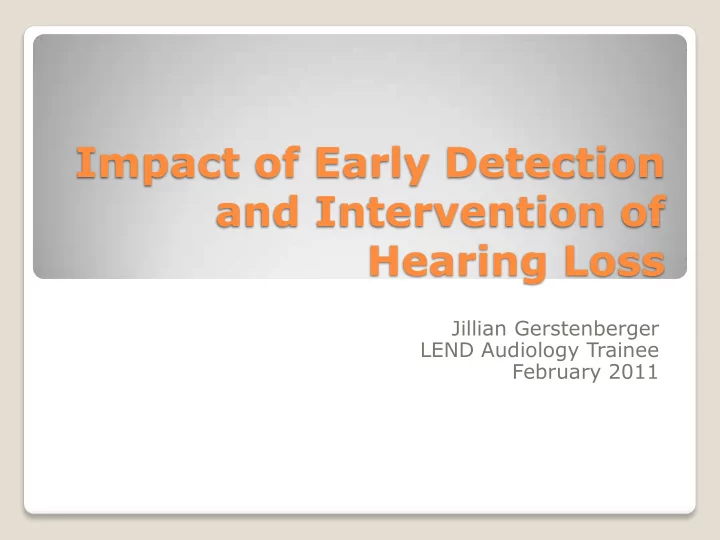

Impact of Early Detection and Intervention of Hearing Loss Jillian Gerstenberger LEND Audiology Trainee February 2011
Why Universal Newborn Screen? Impact of Early Detection and Intervention UNHS, JCIH, EDHI Advocacy at Local, State, and National Level Objectives
Heelstick Prick ◦ Test for a specific number of conditions Varies state-to-state what conditions are included ◦ Example: Indiana tested for 44 conditions (including sickle cell anemia and hearing loss) Babies born at home must be tested within one week after birth ◦ NBS State-By-State Interactive Map Florida: January 2011 – voted to at SCID (Severe Combined Immunodeficiency) added to conditions tested for at birth. Severe defect in T cell production Handout: Newborn Screen Disorders – State-by-State breakdown Universal Newborn Screen
Every day in the US 33 babies are born with permanent hearing loss. Approximately 1 in 1,000 newborns are born profoundly deaf with another 2-3 out of 1,000 babies born with partial hearing loss, making hearing loss one of the most common birth defects in America. (National Center on Hearing Assessment and Management) Until the 1990s, children born with permanent hearing loss typically would not have been identified and diagnosed until 2½ to 3 years of age. Since initiation of newborn hearing screening and EHDI programs, the average age confirmed hearing loss has decreased to 2-3 months of age. (J. Hoffman & K. Beauchaine; M. Harrison, J. Roush, & J. Wallace) Universal Newborn HEARING Screening (UNHS)
When deaf children are not identified early and given appropriate services, additional special education services beyond what would have otherwise been required can cost an additional $500,000 for the local school district. (J. Johnson, et al., 1993) Approximately 2.5 million , or 5.4%, of all school-aged children, have mild or unilateral hearing loss . Over 1/3 of these children are projected to fail at least one grade and/or will require additional educational support, costing the educational system over $5.5 billion . (J. Hoffman & K. Beauchaine, 2007) Universal Newborn HEARING Screening (UNHS)
1969 ◦ Formed: audiology, otolaryngology, pediatrics and nursing. 1972 ◦ First delineated the first high-risk factors for hearing loss and recommended following infants with these high risk factors: history of hereditary childhood hearing impairment, congenital perinatal infection such as rubella or other nonbacterial fetal infection like cytomegalovirus, and herpes; craniofacial anomalies, birth weight less than 1500 grams and a bilirubin level greater than 20. 1982 & 1994 ◦ Revised: More risk factors for HL added 2000 ◦ Recommends universal screening of hearing loss before hospital discharge and identifies Principles and Guidelines for hospital and state level programs. Joint Committee on Infant Hearing (JCIH)
Basic EHDI Components ◦ Newborn Hearing Screening ◦ Pediatric Diagnostic Audiological Evaluation ◦ Early Intervention Early Hearing Detection and Intervention Program (EHDI)
Maternal and Child Health Bureau ◦ Early Hearing and Detection Intervention (EHDI) Grants Florida Department of Health – Newborn Screening Advisory Committee UM – Mailman Center for Child Development – Department of Audiology and Speech Language Pathology Advocacy
Indiana Government website ◦ http://www.in.gov/isdh/20215.htm National Newborn Screening & Genetics Resource Center ◦ http://genes-r-us.uthscsa.edu/ National Center on Hearing Assessment and Management. ◦ http://www.infanthearing.org/resources/fact.pdf Hoffman, J., and Beauchaine, K. (2007, Feb 13). Babies with hearing loss: Steps for effective intervention. The ASHA Leader, 12(2), 8-9, 22-23 Harrison, M., Roush, J., & Wallace, J. (2003). Trends in age of identification and intervention in infants with hearing loss. Ear and Hearing, 24, 89-95. Joint Committee on Infant Hearing. (2007). Year 2007 position statement: Principles and guidelines for early hearing detection and intervention . Available at www.asha.org/policy. Johnson JL, Mauk GW, Takekawa KM, Simon PR, Sia CCJ, Blackwell PM. Implementing a statewide system of services for infants and toddlers with hearing disabilities. Seminars in Hearing. 1993;14:105-119. Hoffman, J., and Beauchaine, K. (2007, Feb 13). Babies with hearing loss: Steps for effective intervention. The ASHA Leader, 12(2), 8-9, 22-23. References
Recommend
More recommend